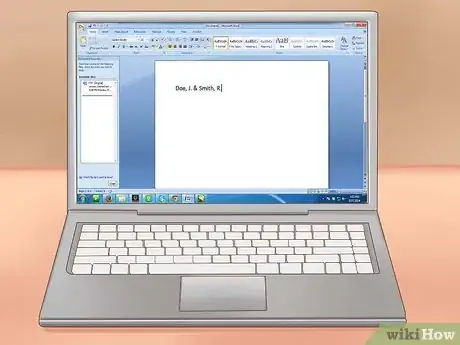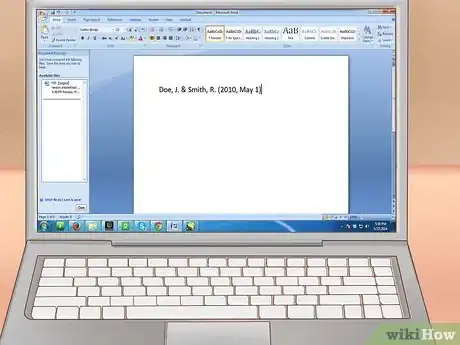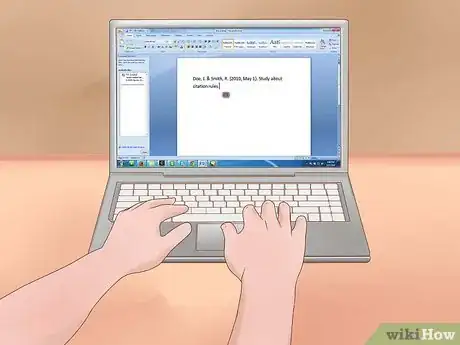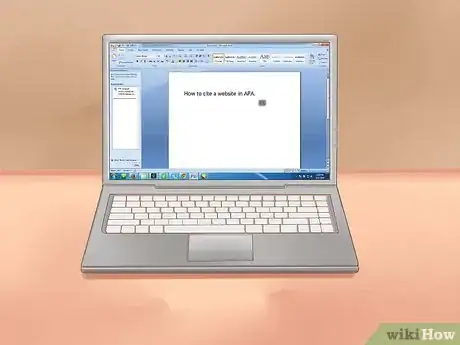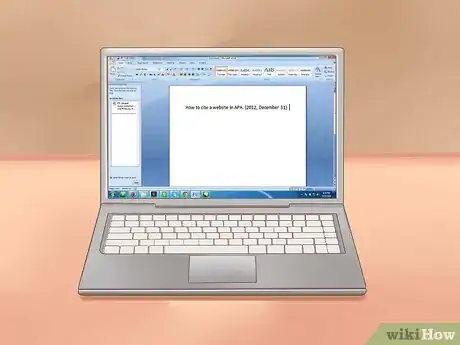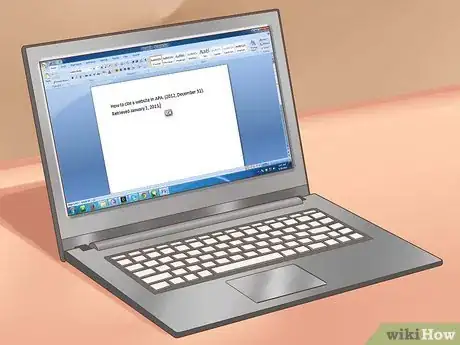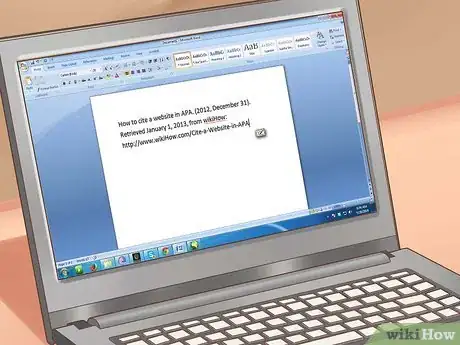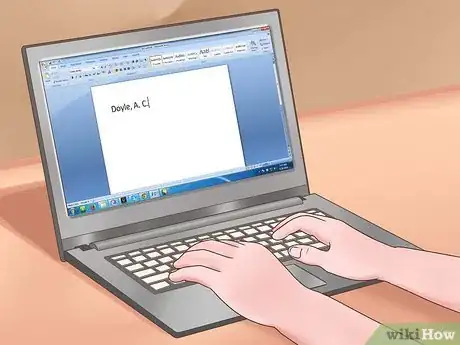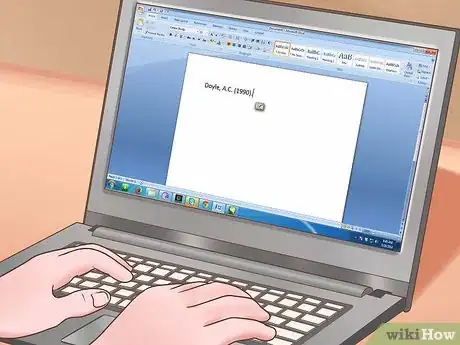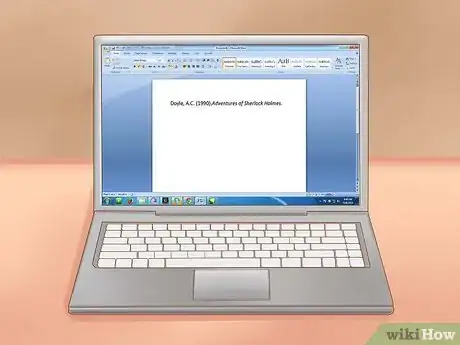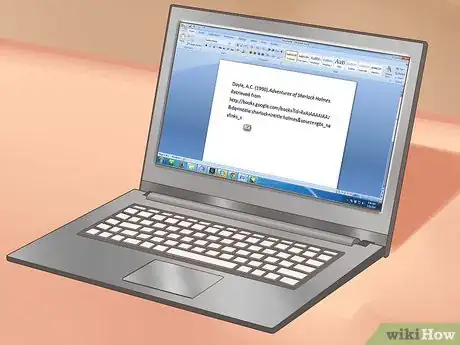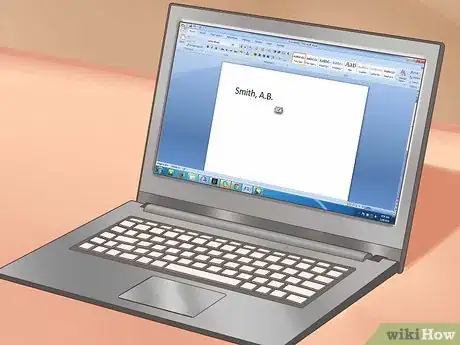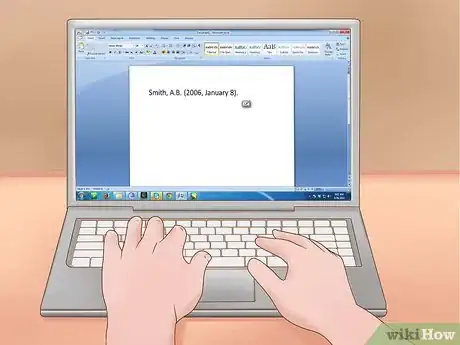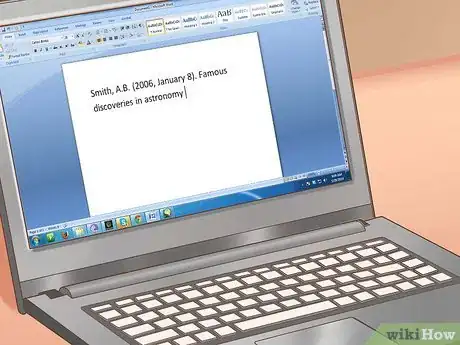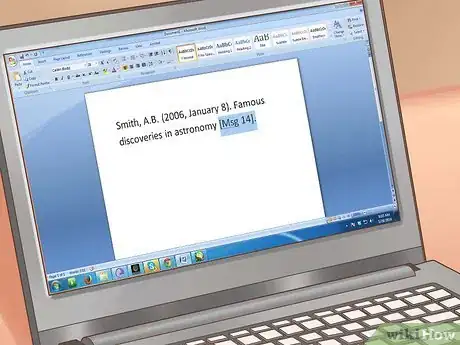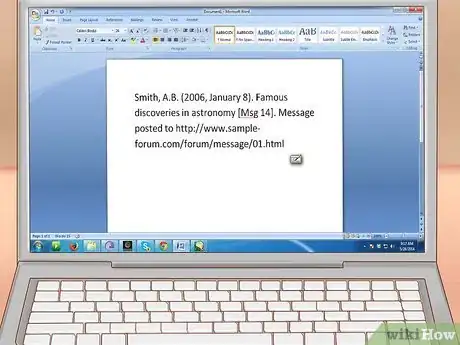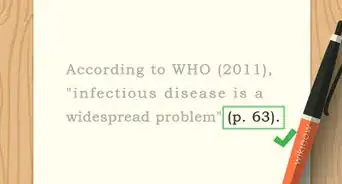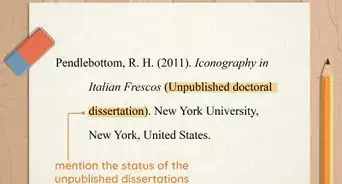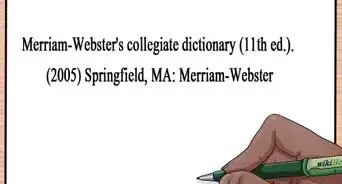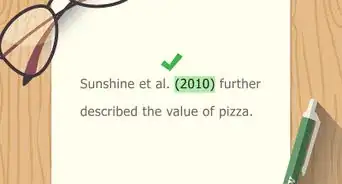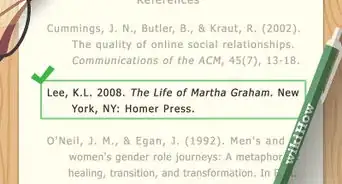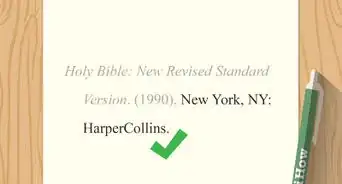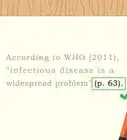This article was co-authored by Cara Barker, MA. Cara Barker is an Assistant Professor and Research and Instruction Librarian at Hunter Library at Western Carolina University. She received her Masters in Library and Information Sciences from the University of Washington in 2014. She has over 16 years of experience working with libraries across the United States.
There are 10 references cited in this article, which can be found at the bottom of the page.
This article has been viewed 170,945 times.
If you need to cite a standard webpage, a blog post, a book that isn't published in print, or a forum post in APA format, you've come to the right place. All you have to do is follow a few simple steps to order and format the information correctly. Keep in mind that books, articles, and magazines published online should be cited in the same way as printed books, articles, and magazines.
Steps
Website or Blog
-
1Write the name of the author. In your reference list, the author’s name should be in last-name, first-initial format. If there are multiple authors, list each one in last-name, first-initial format and separate the names with commas, separating the final name with an ampersand (&). For instance:[1]
- Doe, J.
- Wilcox, M. & Smith, R.
-
2Indicate the date of publication. The date should be in year-month-day format with a comma separating the year and the month. Type it in parentheses and follow it with a period. For example:[2]
- Doe, J. (2012, December 31).
- Wilcox, M. & Smith, R. (2010, May 1).
Advertisement -
3List the title of the document. This is the name of the webpage or blog post, not the overall website or blog. Only capitalize the first letter of the first word, and conclude with a period. Here are some examples:[3]
- Doe, J. (2012, December 31). Statistics and analysis.
- Wilcox, M. & Smith, R. (2010, May 1). Study about citation rules.
-
4Write a description of the format. Next, describe what kind of online publication you're citing, such as a blog post or web page. Capitalize the first letter of the format, put the info in brackets, and end with a period. For instance:[4]
- Doe, J. (2012, December 31). Statistics and analysis [Web page].
- Wilcox, M. & Smith, R. (2010, May 1). Study about citation rules. [Blog post].
-
5Finish by specifying where the information was retrieved. Write "Retrieved from" and then list the URL of the page you're citing. For example:[5]
- Doe, J. (2012, December 31). Statistics and analysis [Web page]. Retrieved from http://www.onlinestats.com/12312012/analysisofstats
- Wilcox, M. & Smith, R. (2010, May 1). Study about citation rules. [Blog post]. Retrieved from http://www.myblog.com/117893
-
6List just the author and year for an in-text citation. If you need to include an in-text citation, simply type an opening parenthesis, write the author’s last name, add a comma, then note the publishing year. Finish by closing the parentheses. If you’re quoting or paraphrasing a specific part of the text, include a paragraph number if possible.[6] For instance:[7]
- (Doe, 2012).
- (Wilcox & Smith, 2010).
- (Wooster, 2019, para. 2).
Website with No Author
-
1Indicate the name of the article or page. Do not put the title in quotations or italics. Capitalize only the first letter of the first word, as well as any proper nouns. Follow with a period. For example:[8]
- Analysis of the Colorado River.
-
2Specify the date of publication, if possible. Put the date in parentheses, arranging it in year-month-day format with a comma between the year and the month. If only the year is available, list the year. If no date is available, write "n.d." Follow the parentheses with a period. For instance:[9]
- Analysis of the Colorado River. (2011, May 28).
- Running out of water in the U.S. (n.d.).
-
3Include the date of retrieval. The retrieval date is the date when you last looked at the website and got information from it. Introduce the date with the word "Retrieved." Type the date in month-day-year format, and follow with a comma. Here's an example:[10]
- Analysis of the Colorado River. (2011, May 28). Retrieved January 1, 2013,
-
4Cite the name of the website and the URL from which you obtained the information. Introduce the information with the word "from." Name the website, then follow it with a colon. Finish with the URL.[11]
- Analysis of the Colorado River. (2011, May 28).
Online Book
-
1Use this format only if the book has never been printed. In most cases, books found online should be cited the same way that printed books are cited. However, if the book is only available online and not in print, the format is slightly different.[12]
-
2Name the author or authors. Each name should be in last-name, first-initial format. Include the author's middle initial when available.[13]
- Davis, J.
- Doyle, A. C.
-
3Indicate the date of publication. The date should be in year-month-day format with a comma after the year. Enclose the date in parentheses. If no date is available, write the abbreviation "n.d." Follow the parentheses with a period.[14]
- Davis, J. (n.d.).
- Doyle, A. C. (1900).
-
4Type the name of the online e-book. Italicize the title and capitalize the first letter of the first word. If there is a subtitle, also capitalize the first letter of the first word that appears after the colon.[15]
- Davis, J. (n.d.). Familiar birdsongs of the Northwest
- Doyle, A. C. (1900). Adventures of Sherlock Holmes
-
5Describe the format of the book. After including the title, put the format of the book in brackets. End with a period.
- Davis, J. (n.d.). Familiar birdsongs of the Northwest [Kindle X version].
- Doyle, A.C. (1900). Adventures of Sherlock Holmes [EPUB version].
-
6Specify the URL. If the work is available directly, introduce the URL with the phrase "Retrieved from." If it must be purchased or is not directly available, introduce the URL with the phrase "Available from."[16]
- Davis, J. (n.d.). Familiar birdsongs of the Northwest [EPUB version]. Available from https://www.powells.com/cgi-bin/biblio? inkey=1-9780931686108-0
- Doyle, A. C. (1900). Adventures of Sherlock Holmes [EPUB version]. Retrieved from http://books.google.com/books
Forum Website
-
1Mention the author's name or username. When available, you should use the author's actual name in last-name, first-initial, middle-initial format. If the author does not indicate their real name, however, you must include the author's screen name or username.[17]
- Smith, A. B.
- JellybeanLover1900.
-
2Include the date of publication. Due to the nature of online message boards and forums, the date of publication is almost always included with each post. Write the date in year-month-day format and enclose it in parentheses. Follow with a period.[18]
- Smith, A. B. (2006, January 8).
-
3Write the name of the post. Capitalize the first letter of the first word. Do not italicize or enclose the title in quotation marks.[19]
- Smith, A. B. (2006, January 8). Famous discoveries in astronomy
-
4Include identifiers, if possible. If the post or message number is available, indicate it in brackets. If unavailable, however, skip this step. Follow with a period.[20]
- Smith, A. B. (2006, January 8). Famous discoveries in astronomy [Msg 14].
- Doe, J. (2008, October 17). New news to report.
-
5Write the URL where the message was posted. Include the specific URL of the thread and introduce it with the phrase "Message posted to."[21]
- Smith, A. B. (2006, January 8). Famous discoveries in astronomy [Msg 14]. Message posted to http://www.sample-forum.com/forum/messages/01.html
Community Q&A
-
QuestionHow do I cite a source retrieved from a password-protected website in an APA-style paper?
 Community AnswerThe fact that it's from a password-protected website shouldn't affect how you cite it, so you can cite it as you normally would using the instructions in this article.
Community AnswerThe fact that it's from a password-protected website shouldn't affect how you cite it, so you can cite it as you normally would using the instructions in this article. -
QuestionHow do I cite a website in the body of my paper?
 Community AnswerLast name, F. M. (Year, Month, Date Published). Article title. Retrieved from URL.
Community AnswerLast name, F. M. (Year, Month, Date Published). Article title. Retrieved from URL.
References
- ↑ https://apastyle.apa.org/style-grammar-guidelines/references/examples/webpage-website-references
- ↑ https://libraryguides.vu.edu.au/apa-referencing/7Webpages
- ↑ https://apastyle.apa.org/style-grammar-guidelines/references/examples/webpage-website-references
- ↑ https://libraryguides.vu.edu.au/apa-referencing/7Webpages
- ↑ https://apastyle.apa.org/style-grammar-guidelines/references/examples/webpage-website-references
- ↑ https://columbiacollege-ca.libguides.com/apa/websites
- ↑ https://guides.libraries.psu.edu/apaquickguide/intext
- ↑ https://apastyle.apa.org/learn/faqs/web-page-no-author
- ↑ https://apastyle.apa.org/learn/faqs/web-page-no-author
- ↑ https://apastyle.apa.org/learn/faqs/web-page-no-author
- ↑ https://apastyle.apa.org/learn/faqs/web-page-no-author
- ↑ https://owl.purdue.edu/owl/research_and_citation/apa_style/apa_formatting_and_style_guide/reference_list_electronic_sources.html
- ↑ https://owl.purdue.edu/owl/research_and_citation/apa_style/apa_formatting_and_style_guide/reference_list_electronic_sources.html
- ↑ https://owl.purdue.edu/owl/research_and_citation/apa_style/apa_formatting_and_style_guide/reference_list_electronic_sources.html
- ↑ https://owl.purdue.edu/owl/research_and_citation/apa_style/apa_formatting_and_style_guide/reference_list_electronic_sources.html
- ↑ https://owl.purdue.edu/owl/research_and_citation/apa_style/apa_formatting_and_style_guide/reference_list_electronic_sources.html
- ↑ https://apastyle.apa.org/style-grammar-guidelines/references/examples/online-forum-references
- ↑ https://library.ulethbridge.ca/apa7style/online/blog
- ↑ https://apastyle.apa.org/style-grammar-guidelines/references/examples/online-forum-references
- ↑ https://library.ulethbridge.ca/apa7style/online/blog
- ↑ https://apastyle.apa.org/style-grammar-guidelines/references/examples/online-forum-references
- ↑ https://apastyle.apa.org/style-grammar-guidelines/references/examples/journal-article-references
- ↑ https://www.landmark.edu/library/citation-guides/apa-citation-style-guide#Entire%20Websites
About This Article
To cite a website in APA, start by writing the name of the author with their last name first, followed by their first initial. Next, note the date that the post was published and put it in parentheses, followed by a period. Then, give the title of the post or webpage, making sure to capitalize only the first letter of the first word. After the title, describe the format in brackets, such as “[Blog post]” or [Web page].” Finally, write “Retrieved from,” then record the exact URL of the page you refer to in your paper. To learn how to cite a website if there’s no author information, read on!
